A theme is a combination of desktop background pictures, Window colors, sound scheme and a screensaver. Windows 7 introduces a new file format (.themepack) which is basically a .cab file that can contain images, audio files for sound scheme, mouse cursors, icons and the .theme file itself. This file format was introduced so that it’s easier to share themes to other Windows 7 systems. Another format with .deskthemepack extension was introduced in Windows 8, which can also be used for this tutorial. Instructions in this post works in Windows 7, 8 and Windows 10 systems as well.
When a .themepack or .deskthemepack file is run, it extracts the contents automatically to the following folder:
%localappdata%\Microsoft\Windows\Themes
As you see, it’s stored within the user profile folder, and the theme is available only for that user, and listed under "My Themes" in Personalization applet.
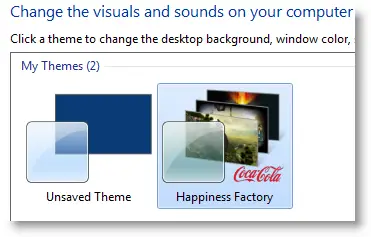
If another user in the same computer needs this theme, they need to run the theme pack file again, from their user account. This article tells you how to make available a Desktop Theme for all users in a computer, so that there are no redundant copies of theme files in the system.
Install a Theme For All User Accounts
I’ll how you how to install a desktop theme for all users. For illustration purposes, we’ll use the following themes as samples, and make them available in the Personalization page for ALL user accounts.
- HappinessFactory (Coca-Cola) Theme
- Fruit Ninja Theme (this would be in Page 2 of the article)
Before starting, uncheck the "Hide extensions for known file types" setting in Folder Options – View tab. (REF Show or hide file name extensions)
HappinessFactory
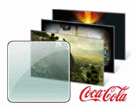
Download the Happiness Factory theme from Microsoft and save to Desktop. Rename Happiness Factory_Windows7.themepack to Happiness Factory_Windows7.cab.
Create a folder on your Desktop, and name it as HappinessFactory.
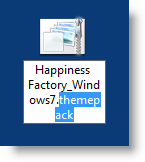
Double-click the file Happiness Factory_Windows7.cab to view its contents. Select all files, right-click and choose Extract…
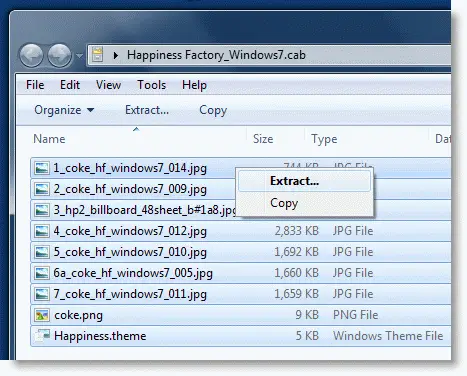
Select the HappinessFactory folder and click Extract
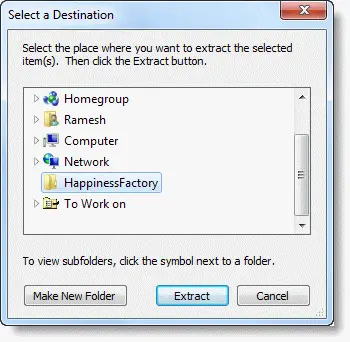
Click Save. Do this for every file.
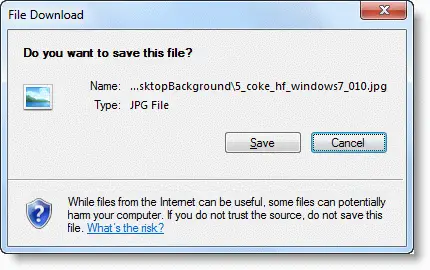
Double-click HappinessFactory folder, and create a sub-folder named DesktopBackground
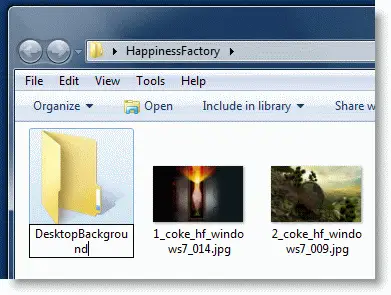
Move all the JPG images to the DesktopBackground folder.
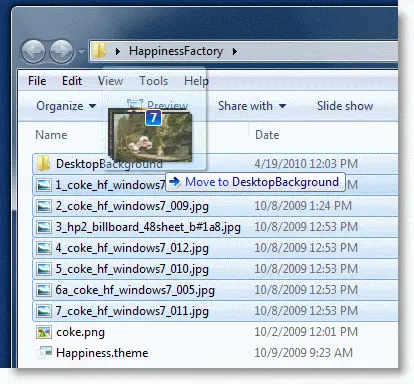
Open the .theme file (Happiness.theme) using Notepad, and input the correct paths for the wallpaper, desktop slideshow, screensaver, brand logo and other resources.
Updating the Brand Logo image path:

We’ll change that to:

Originally the Wallpaper path was as in the image below.
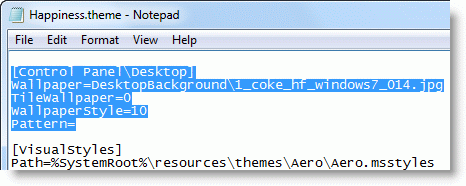
We’ll change that to the following absolute path, as we’re eventually going to place the theme under the C:\Windows\Resources\Themes folder.

Then scroll down to the [Slideshow] section, and delete the ImagesRootPIDL entry.
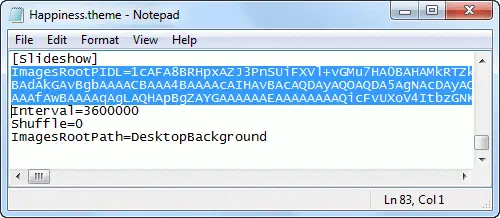
Update the location for the ImagesRootPath accordingly (as below)
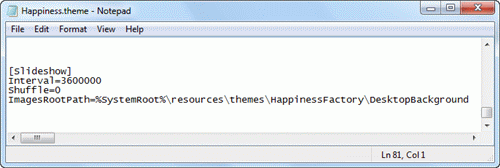
Save the .theme file and close Notepad.
Move the folder HappinessFactory from your Desktop to C:\Windows\Resources\Themes
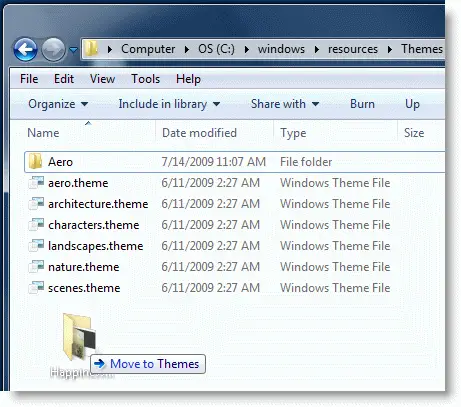
Click Continue when you see the User Account Control prompt. You may have to type the administrator password if prompted.
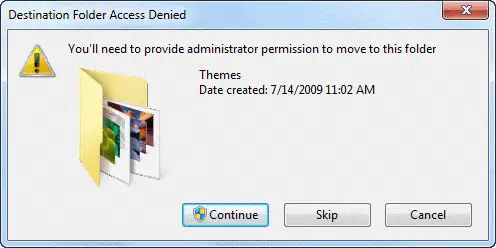
Now move the file Happiness.theme from the HappinessFactory folder to its parent folder, which is C:\Windows\Resources\Themes
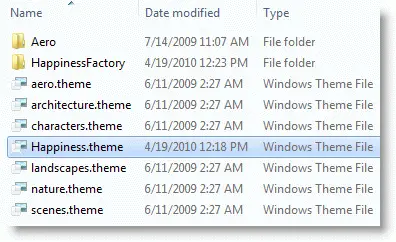
Right-click on your desktop, and choose Personalize.
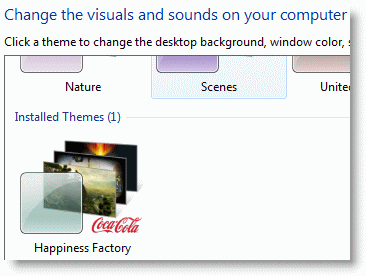
The Happiness Factory Theme is now listed under Installed Themes, which is accessible for all users in the system.
Check Page 2 of this article to see another example, using the colorful Fruit Ninja Theme!
One small request: If you liked this post, please share this?
One "tiny" share from you would seriously help a lot with the growth of this blog. Some great suggestions:- Pin it!
- Share it to your favorite blog + Facebook, Reddit
- Tweet it!

OR simply put the theme in %windir%\Resources\Themes. That makes it appear under “Installed themes”. 🙂
@anon: If the theme file contains relative paths, simply copying the theme files/folder to the Resources\Themes folder would just do it. But that doesn’t simply work if the source .theme file already contains *absolute* paths. Also, this article is intended to provide some background info on customizing/applying themes, but just takes the Coke theme as an example 🙂
Hmmm… Good article. The process, however, seems complicated.
Perhaps I could use Visual C# Express 2008 to develop an application for handling ThemePack files … properly!
Thanks for this, very useful. One thing I have noticed though is that the theme doesn’t appear as a slideshow, it only shows the static wallpaper that’s set in the [Control Panel\Desktop] section. Until I click on Desktop Background under Personalize, and then it suddenly becomes a slideshow – but it also becomes a customised theme. Any way around this?
I found that to make the slideshow function you will need to add a section to the .theme file as follows
[Slideshow]
Interval=1800000
Shuffle=0
ImagesRootPath=%SystemRoot%\Resources\Themes\Arctic\DesktopBackground
Change the ImagesRootPath to point to the folder containing the images you want as part of the slide show. Change the Intreval value to change the speed of the slide show. This worked for me.
Does anyone know how I can upload my themepacks to the Microsoft website?
http://windows.microsoft.com/en-us/windows/downloads/personalize/themes
Great article. What does the BrandImage do?
Hello, Whats the correct path for sounds? The theme works great but no sound. thanks for the cool article
Thanks for this great guide. 🙂
But what should I do to have the same result in windows 8.1 with deskthemepack?
Thanks in advance
Tony
said this on Friday, August 6th 2010 7:19 am
Thanks for this, very useful. One thing I have noticed though is that the theme doesn’t appear as a slideshow, it only shows the static wallpaper that’s set in the [Control Panel\Desktop] section. Until I click on Desktop Background under Personalize, and then it suddenly becomes a slideshow – but it also becomes a customised theme. Any way around this?
Tony, I know this very late, but I had the same problem. The issue was I had used GPO to set Wallpaper. I removed this settings and the theme is now a slide show.
For users who commented in this page, please check Page 2 for a new write-up using another sample, the colorful Fruit Ninja theme 🙂 https://www.winhelponline.com/blog/share-desktop-theme-common-all-users/2/